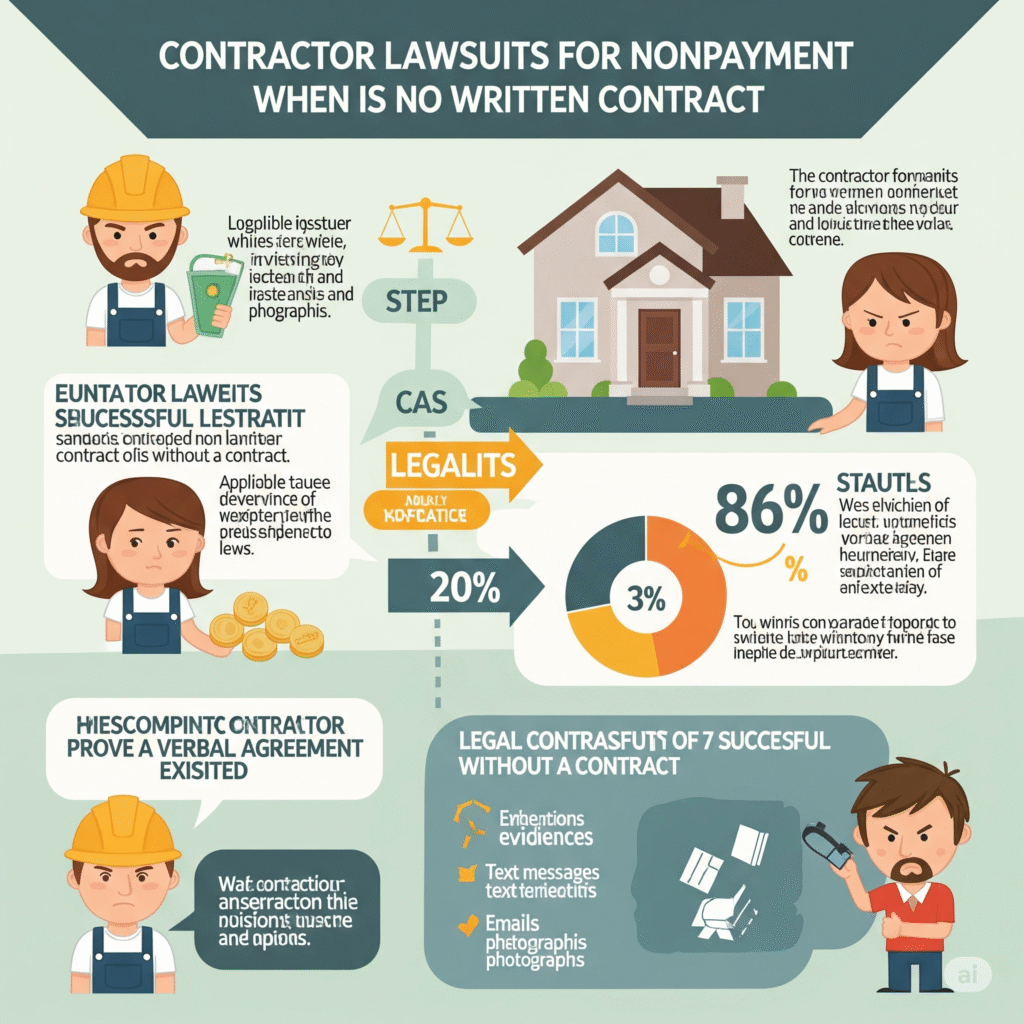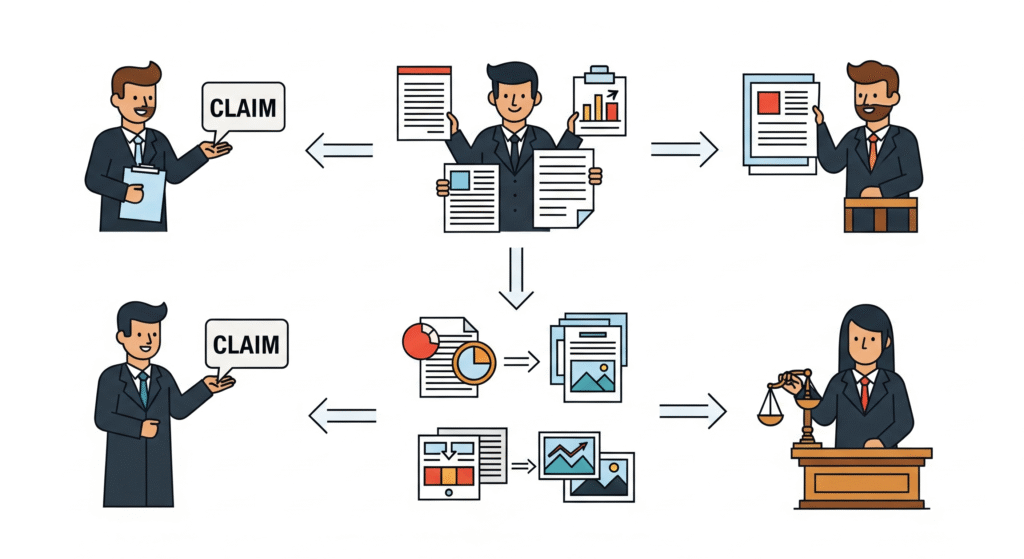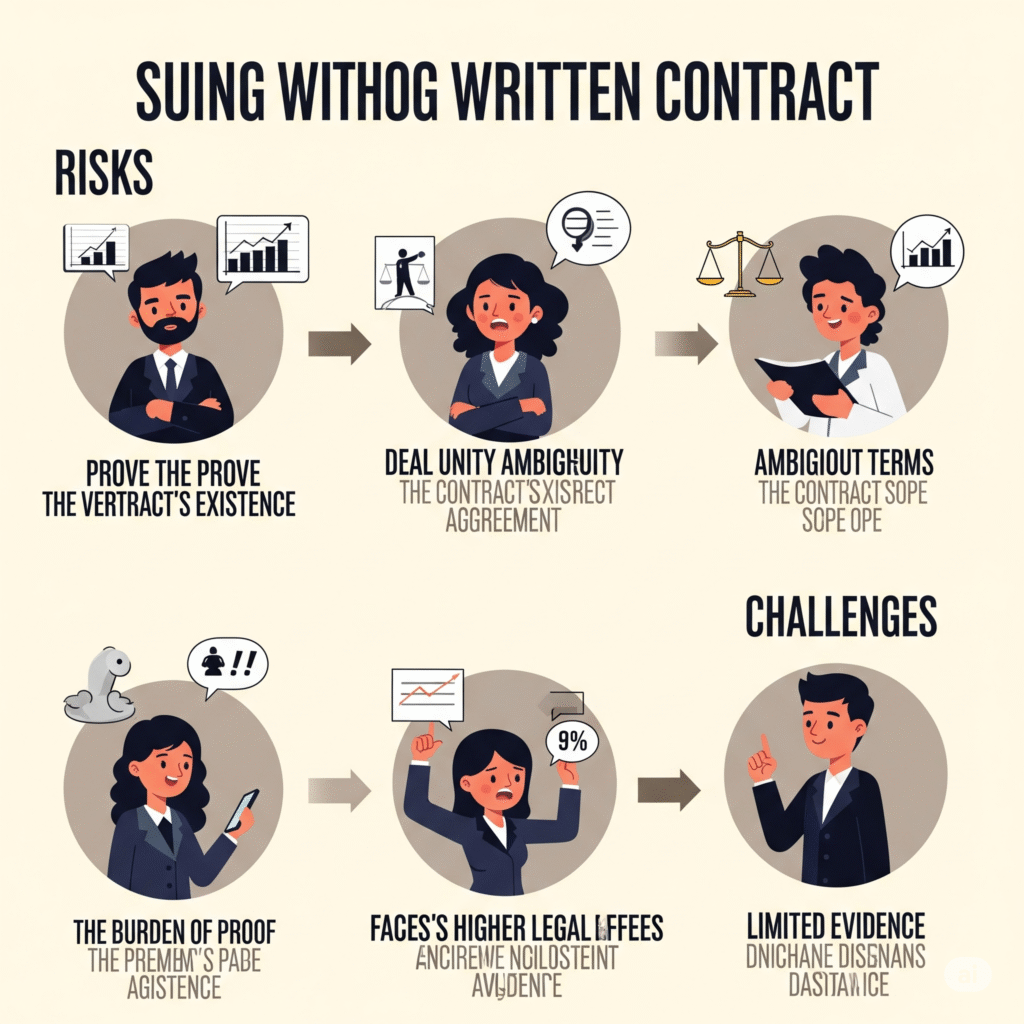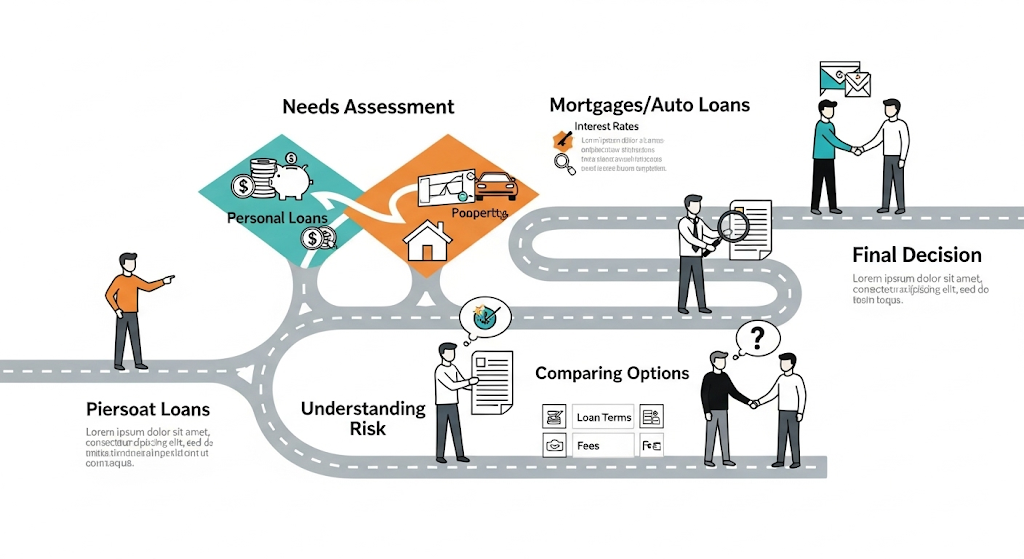
Can a contractor sue for nonpayment without a contract
Contractors often face challenges when clients fail to pay for completed work, particularly in situations where no written agreement exists. However, a contractor can sue for nonpayment without a contract by relying on verbal agreements, implied contracts, or legal doctrines such as quantum meruit. While a written contract strengthens a legal case, the absence of one does not eliminate the right to seek compensation through the courts.
Proving the existence and terms of such agreements usually requires solid evidence, such as communications, invoices, or witness testimony. The process is more complex and may vary by jurisdiction, but legal options do exist for contractors seeking payment under these circumstances.
Understanding Contractor Rights in Absence of a Contract
Contractors can pursue payment even without a written contract, but success depends on what legal principles apply and the evidence they present. Various mechanisms allow contractors to claim compensation based on the work performed or agreements made, though challenges arise in proving terms and amounts.
Implied Contracts and Quantum Meruit
An implied contract arises when the actions of both parties suggest an agreement existed, despite no formal document. For contractors, this means if work was performed with the property owner’s knowledge and acceptance, the law may recognize an obligation to pay.
Quantum meruit is a legal principle that allows contractors to recover the reasonable value of their work even without an explicit contract. It prevents unjust enrichment, meaning the client must compensate the contractor for labor or materials supplied.
Contractors must demonstrate their work was requested and completed satisfactorily. The fair market value of services typically determines payment amounts, which courts consider when enforcing quantum meruit claims.
Verbal Agreements and Legal Standing
Oral contracts can be legally binding if they satisfy the essential terms typically required in written agreements. Contractors who have a verbal agreement supported by clear communication, documented acknowledgment, or payment installments have stronger grounds to sue.
However, verbal contracts face limitations under state laws, including shorter statutes of limitations and difficulties proving agreed terms. Disputes often arise over project scope or payment amounts without physical evidence.
Maintaining detailed records such as emails, messages, or witnesses can strengthen the contractor’s position. Courts generally assess the credibility and consistency of such evidence in determining enforceability.
Elements Required for Legal Claim
To file a legal claim for non-payment without a written contract, contractors need to prove several key elements. First, there must be proof that work was performed or materials supplied.
Second, evidence must show the client accepted or benefited from the work. Third, the contractor must establish the amount owed, typically through invoices, estimates, or market rates.
Finally, demonstrating that payment was requested but withheld strengthens the case. The burden of proof is higher when no written contract exists, making comprehensive documentation essential for a successful claim.
Legal Pathways for Contractors Seeking Payment
Contractors can pursue payment through various legal routes, even without a formal written contract. These options often rely on verbal agreements, implied contracts, or legal principles like quantum meruit to establish the right to compensation.
Filing a Lawsuit Without a Written Contract
A contractor can file a lawsuit based on verbal or implied agreements. Courts may consider evidence like emails, text messages, invoices, or witness testimony to prove the contractor provided labor or materials.
Legal claims often use the principle of quantum meruit, which allows a contractor to recover the reasonable value of work performed. This approach protects contractors who completed work benefiting the client.
Filing a lawsuit involves costs such as legal fees and court costs. Contractors should consider alternative remedies like mechanic’s liens or mediation before pursuing court action.
Role of Small Claims Court
Small claims court is a practical option for contractors seeking payment of relatively modest amounts. It offers a faster, less formal process with lower fees compared to regular courts.
Contractors can represent themselves without hiring attorneys, reducing legal costs. However, the court has monetary limits varying by state, typically ranging from $5,000 to $15,000.
Using small claims court can be effective for recovering overdue payments, especially when pursuing payment without a written contract. It provides a streamlined setting to present evidence of work completed and amounts owed.
Burden of Proof in Disputes
Without a written contract, the contractor must prove the existence of an agreement and the value of the work performed. This requires clear, convincing evidence showing the client accepted and benefited from the work.
Documentation such as invoices, payment records, correspondence, and project notes strengthens the contractor’s case. Testimony from subcontractors or witnesses may also support claims.
The contractor’s ability to demonstrate the reasonable value of services is key, especially under quantum meruit claims. Failure to provide sufficient proof can result in dismissal or reduced compensation.
| Evidence Type | Purpose | Example |
|---|---|---|
| Invoices | Show work done and amounts owed | Final project invoice |
| Correspondence | Prove communication and agreements | Emails discussing payments |
| Witness Testimony | Confirm work performed and acceptance | Statements from subcontractors |
| Payment Records | Detail partial payments made | Bank transfer receipts |
Evidence and Documentation to Support Your Claim

Proving a non-payment claim without a written contract requires clear and organized evidence. This includes financial records, communications, witness accounts, and proof of completed work. Each element helps establish the existence of an agreement and the contractor’s entitlement to payment.
Importance of Invoices and Communications
Invoices are critical for showing the amount owed and the work performed. A detailed invoice lists services, materials, dates, and payment terms. Contractors should keep copies of all invoices sent to the client.
Written communications—such as emails, text messages, or letters—track the agreement process and payment discussions. These documents serve as evidence of verbal or implied contracts. Communications that confirm work acceptance or payment promises strengthen the contractor’s case significantly.
Clear timestamps and consistent records are essential. Without them, proving the obligations and agreed terms becomes difficult.
Supporting Testimonies
Testimonies from clients, subcontractors, or third parties involved can support the claim. These statements help verify that work was requested, performed, and unpaid.
Witnesses who observed the contract negotiations or the completion of work provide valuable corroboration. Their accounts can clarify disputed facts, especially when no written contract exists.
It is important that testimonies be clear, specific, and relevant. Providing details such as dates, conversations, and payments discussed can make these statements more credible and persuasive in court.
Photographs and Work Documentation
Photographic evidence of the work at various stages establishes proof of performance. This may include before-and-after images or photos showing completed tasks.
Other documentation, like delivery receipts for materials or time logs, further proves the effort and resources invested.
Together, these items demonstrate that the contractor fulfilled their obligations, which supports the claim for payment. Keeping this evidence organized and date-stamped increases its reliability in legal proceedings.
Risks and Challenges of Suing Without a Written Contract

Suing a contractor for non-payment without a written contract involves several challenges that can complicate the process. The absence of clear documentation often leads to disputes over what was agreed upon, making the case difficult to prove. Defenses by clients and possible counterclaims can increase legal complexity and costs.
Common Defenses Used by Clients
Clients often argue that no enforceable agreement existed, claiming any oral promises were vague or never finalized. They may dispute the scope or quality of work performed, suggesting the contractor did not meet expectations or deadlines.
Another common defense is the statute of limitations. For example, in Georgia, the statute of limitations for contract-related claims, like debt collection, is generally six years, but oral contracts may face shorter limits, affecting the viability of the claim.
Clients might also claim that the contractor was overpaid or that the work was incomplete, which can reduce or negate the amount owed. These defenses place the burden on the contractor to provide strong, clear evidence of the agreement and completed work.
Potential Counterclaims and Legal Costs
Clients may file counterclaims such as breach of contract, fraud, or negligence, especially if they argue the workmanship was substandard or the terms misrepresented. These claims can complicate the proceedings and lead to additional financial exposure for the contractor.
Legal costs tend to rise when cases rely on oral agreements, as evidence collection and witness testimonies increase. Proving the terms and origin of the deal often involves time-consuming procedures, escalating attorney fees and court costs.
Contractors should anticipate longer dispute resolution timelines and the possibility of settling out of court to avoid higher expenses and unpredictable verdicts. Without a written contract, managing potential counterclaims and costs becomes a critical factor in deciding whether to pursue legal action.
Alternatives to Litigation
Contractors seeking payment without a formal contract can pursue options that avoid courtroom disputes. These approaches focus on clear communication and third-party assistance to resolve payment issues efficiently.
Negotiation and Demand Letters
Negotiation is often the first step. A contractor can contact the client directly to discuss the outstanding payment and propose a resolution. This approach can save time and legal costs.
If informal talks stall, sending a demand letter serves as a formal request for payment. The letter should clearly state the amount owed, the work performed, and a deadline for payment. It often encourages the client to act before legal action becomes necessary.
Using a demand letter helps document the contractor’s efforts to collect payment. It also signals seriousness, improving the chance of a resolution without filing a lawsuit.
Mediation and Arbitration
Mediation involves a neutral third party who facilitates a discussion between the contractor and client to reach a voluntary agreement. It is less formal than court and often quicker.
Arbitration is a more structured process where an arbitrator reviews evidence and issues a binding decision. It is faster and less expensive than litigation but still legally enforceable.
Both methods can preserve relationships and reduce costs. Contractors may access mediation or arbitration through industry associations or specialized dispute resolution services. These options also provide flexibility, including remote or on-site sessions.
Using alternatives like mediation or arbitration can avoid the unpredictability and expense of court cases without losing leverage in collecting payment.
Protecting Contractor Payment Rights in the Future
Contractors must take proactive steps to safeguard their payment rights. This involves securing clear agreements, including specific clauses to address payment issues, and managing finances effectively through credit options designed for construction businesses.
The Importance of Written Agreements
Written contracts provide clear evidence of payment terms and project obligations. They reduce disputes by documenting scope, deadlines, and payment schedules explicitly. Without written agreements, proving the terms can become difficult, especially in court.
A written contract should be signed before starting work. It helps establish legal grounds for collection if payment is withheld. Even verbal agreements may be enforceable but often require more effort to prove, increasing risk and delays.
Maintaining thorough records related to the agreement, such as change orders and communications, strengthens a contractor’s position. Clear contracts also help prevent misunderstandings and provide a reference for resolving disagreements promptly.
Essential Contract Clauses for Payment Protection
Including specific clauses focused on payment security is vital. Key clauses should cover payment schedules, late payment penalties, and conditions for withholding work until payment. These set clear expectations and consequences.
Mechanic’s lien rights should be explicitly stated, informing clients of the contractor’s ability to secure payment through property claims if necessary. A clause detailing dispute resolution methods (like mediation or arbitration) can limit costly litigation.
Payment retention or holdback provisions are common in construction contracts. They allow withholding a portion of payment until project completion to guarantee performance. Contractors should clearly define when and how retained funds are released to avoid conflict.
Construction Line of Credit and Financial Strategies
Managing cash flow proactively can mitigate payment delays. A construction line of credit provides access to funds to cover expenses while awaiting client payments. This credit is tailored for contractors with flexible draw amounts based on ongoing needs.
Other options include real estate lines of credit for contractors who own property or unsecured business lines of credit like those offered by Coast Hill Bank. These provide short-term liquidity without tying up assets, useful when payments slow.
Contractors should evaluate credit terms carefully, ensuring manageable interest rates and repayment plans. Combining clear contract provisions with financial tools helps maintain operations and reduces dependency on client payment timing.
Relevant Financial Topics Impacting Contractors
Contractors often face financial challenges related to cash flow, especially when payments are delayed or disputed. Understanding options like home equity borrowing and down payment assistance can help manage expenses during non-payment periods and maintain financial stability.
Home Equity Loans and Lines of Credit
Home equity loans and lines of credit (HELOCs) provide contractors with secured borrowing options using their property’s equity. A closed-end home equity loan offers a lump sum with fixed interest rates, often beneficial in areas like Daly City where second-position loans are common. This allows contractors to access funds with predictable payments.
In contrast, a home equity line of credit is a revolving account. Rates vary by location, such as HELOC rates in Wichita, KS, or Connecticut. These rates tend to be variable and can adjust based on market conditions. Contractors may draw funds as needed, paying interest only on the amount used. Both products leverage home equity but differ in flexibility and repayment structure. This makes them practical for covering short-term cash shortfalls.
Automobile and Real Estate Down Payment Assistance
Down payment assistance programs assist contractors who may lack upfront funds for vehicle or housing purchases. Automobile down payment assistance supports purchasing or leasing essential work vehicles without immediate personal cash output, helping maintain mobility and business operation.
For real estate, assistance programs reduce barriers to homeownership or investment properties. These can be critical if a contractor’s cash flow is disrupted by non-payment issues. Assistance often comes in the form of grants, forgivable loans, or low-interest loans. Knowing availability by region ensures contractors can leverage these resources to stabilize personal and business finances during uncertain payment cycles.
How Credit Practices Impact Contractor Payments

Credit options and payment processes influence how and when contractors receive funds. Managing credit lines and understanding transaction fees can affect cash flow, especially when contracts are absent or enforcement is needed.
Business Lines of Credit and Contractor Financing
Business lines of credit offer contractors flexible access to funds, helping bridge payment gaps caused by late or non-payment. Credit union business credit cards often provide lower interest rates and favorable terms compared to traditional banks, enabling contractors to cover operational costs or materials without immediate cash.
Using these financing tools can maintain work continuity despite delayed client payments. However, reliance on credit requires careful budgeting to avoid accumulating debt. Contractors should assess interest rates, repayment schedules, and credit limits before applying.
Proper credit management also strengthens a contractor’s financial reputation, improving chances for future credit approval and better loan conditions.
Credit Card Transaction Fees and Payment Methods
Accepting credit card payments involves transaction fees that contractors must account for in their pricing or invoicing. Fees vary by provider; for example, AAMCO credit card processing fees may be higher than some credit union business credit cards.
Contractors should clarify if fees apply to payments made by clients or if attorneys handling collections can pass such credit card fees to contractors, as policies differ by jurisdiction and service agreements.
Offering multiple payment options—such as checks, wire transfers, or electronic payments—can reduce fees and speed up payments. Choosing payment methods with lower fees protects the contractor’s net revenue and may facilitate quicker resolution of non-payment disputes.
Understanding Payment Plans and Assistance Programs
Payment plans and assistance programs help manage the financial burden of services when full payment isn’t possible immediately. These options provide structured ways to pay over time, often with little or no interest, making treatments and services more accessible.
Automatic and Supernova Payment Options
Automatic payment options allow clients to set up recurring payments, usually monthly, to avoid missed deadlines. This method often reduces administrative burdens and lowers the risk of non-payment. It’s ideal for clients who prefer predictable, scheduled deductions directly from their bank accounts or credit cards.
Supernova payment plans offer tailored financing for clients with larger balances or multiple outstanding invoices. These plans may include flexible terms and extended payment periods. Supernova payment is commonly used in dental practices and specialized services to help clients afford treatments without upfront full payment. It also supports contractors by ensuring more reliable cash flow while reducing disputes over unpaid balances.
Medical and Dental Service Payment Plans
Orthodontists and dental service providers, including root canal specialists in Seattle, frequently offer payment plans to ease financial strain. These plans commonly break down the total cost into manageable installments.
Such plans may be interest-free for a fixed period or include low interest charges, depending on the provider. Detail-oriented contracts clarify payment amounts, due dates, and penalties. These clear terms help prevent misunderstandings or payment conflicts that might lead to legal action. Payment plans in this sector balance patient needs with practice sustainability by reducing upfront cost barriers while securing eventual full payment.
Tax-Related Payment Considerations
When contractors face non-payment, understanding tax obligations and specific payment types can impact their financial and legal standing. Proper handling of estimated taxes and knowing how certain payment certificates or benefits apply is essential.
Estimated Tax Payments and Their Importance
Contractors must often make estimated tax payments, especially if their income is not subject to withholding. For example, Oregon requires quarterly estimated tax payments if the contractor expects to owe $500 or more in state tax.
Failing to make timely estimated payments can result in penalties and interest. These payments cover both federal and state income taxes and self-employment taxes that contractors owe.
Contractors litigating non-payment claims should keep thorough records of income, including unpaid amounts. These documents are crucial when calculating accurate estimated taxes and may affect any refund or liability after the dispute is resolved.
Payment Certificates and Military Benefits
Certain types of payments, such as the 5 Cent Military Payment Certificate and the $1800 Social Security payment, have unique legal and tax implications.
The 5 Cent Military Payment Certificate historically was a currency used by the U.S. military, but for contractors today, recognition of military-issued certificates or benefits in contracts requires clarity. If these certificates or similar military benefits are part of the payment, their status must be documented to understand tax obligations properly.
The $1800 Social Security Payment refers to stimulus or Social Security benefit amounts subject to tax rules. Contractors receiving Social Security benefits who also perform contract work should note that these benefits do not typically affect tax filing but may require reporting if combined income reaches certain thresholds.
Understanding these payments ensures contractors properly calculate taxes and do not overlook government benefits when addressing unpaid contract amounts.




